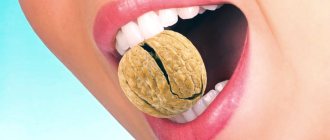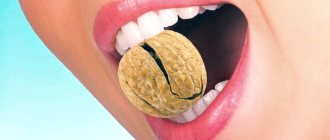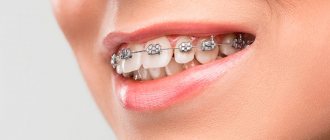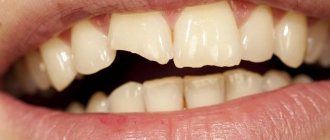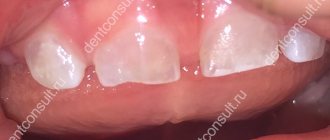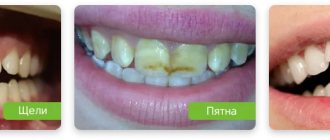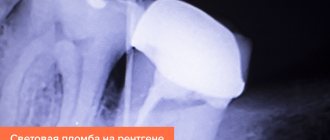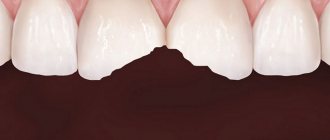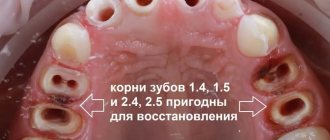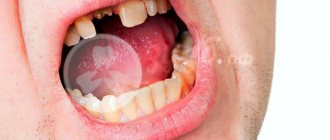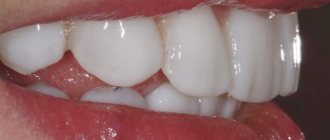Tooth loss is a disease in which, under the influence of negative factors, the integrity of the dentition is disrupted (due to the loss of one or more teeth). This disease is called edentulism.
Teeth are an important element of the human body. We lose them starting from childhood: healthy, strong teeth grow in place of lost milk teeth. Losing permanent teeth is a serious problem because a new tooth will not grow in the vacant space.
Causes of tooth loss
It is clear that teeth do not fall out on their own; this process is facilitated by various diseases of the periodontal tissue and gums. The reasons why a person may lose one or more teeth can be divided into objective and subjective. The first group includes phenomena that depend little on us or do not depend at all, the second group includes our erroneous actions or deliberate inaction.
Objective reasons
Chronic diseases are the main objective reason why seemingly healthy teeth begin to loosen and fall out: diabetes, cardiovascular diseases, stomach ulcers or duodenal diseases seriously affect the health of the oral cavity.
To better understand the nature of tooth loss, we will briefly talk about the negative effects of some chronic diseases. For example, diabetes is a disorder of blood sugar levels. Excess glucose leads to impaired blood supply to the gums, and due to impaired mineral metabolism, the enamel becomes thinner. A person with heart disease often takes medications that cause dry mouth, interfering with the normal functioning of the oral mucosa. Taking calcium antagonists (hypertension medications) can cause gum overgrowth.
One of the reasons leading to tooth loss is injury (as a result of an accident, while playing sports, during incidents). Often, after receiving a blow to the lower or upper jaw, you can lose one or more teeth.
Heredity is an important factor influencing the formation of a baby’s dental tissue in the mother’s womb. Poor nutrition and bad habits of the expectant mother can also affect the buds of teeth.
Subjective reasons
Failure to maintain oral hygiene leads to diseases of the gums and teeth. Lack of habit of regularly brushing your teeth to prevent pathogenic bacteria that penetrate under the gum tissue, forming tartar and plaque on the teeth.
The main enemies of the oral cavity are carbonated water and sugar, which, when combined, destroy tooth enamel and provide food for bacteria that destroy gums and dental tissue. They cause tooth decay and periodontitis, the most common diseases that occur in people who consume candy and soda.
Bad habits also make a destructive contribution to tooth loss - tobacco smoke contains a long list of toxic substances that do not add health to teeth and gums.
People cause some injuries to their teeth quite deliberately, for example, by opening bottle caps with their teeth. The fact that a tooth did not break due to such abuse does not mean that it will pass without a trace for him: in combination with other factors, everything can end in tooth loss.
Unfortunately, fears and worries about visiting the dental office and possible pain often repel patients from the opportunity to protect their teeth. No money? If a tooth falls out, the prosthesis will be much more expensive.
A longitudinal (vertical) crack appeared on the tooth
Shallow cracks along the tooth that do not extend under the gums are eliminated with a composite material and subsequent installation of veneers. Thin overlays mask the aesthetic defect and strengthen the crown, preventing its further destruction. Molars experience increased chewing load, so cracks on them require the use of ceramic/zirconium crowns.
A deep vertical crack often leads to pulpitis. In this case, it is necessary to remove the nerve and carry out a step-by-step reconstruction of the tooth (filling, veneer or crown).
With a strong impact, a vertical crack extends to the root of the tooth. It is possible to restore a tooth if the root is at least one third intact, and the patient immediately seeks help. An attempt to save a dead tooth in this way with partial damage to a single root (incisors, canines and sometimes premolars) often leads to the gradual destruction of the entire root system. In such cases, the only correct option is tooth extraction and subsequent prosthetics/implantation.
Important! Since a pulpless tooth does not receive nutrition, the enamel quickly loses its strength. Therefore, it is advisable to install a crown on a cracked tooth without a nerve (the root is not damaged).
Horizontal tooth crack
A crack surrounding a tooth often does not affect the pulp, so the nerve can be preserved. Tooth restoration includes the use of a composite and restoration with crowns or veneers (front only). Without timely treatment, a transverse crack leads to partial chipping of the tooth. The dentist builds up the broken area with a composite material.
A high risk of tooth loss is caused by a horizontal crack formed at the gum line. In this place the tooth is most vulnerable; the crown can completely (or most of it) break off even from a small load. In fact, the tooth is lost, but it is quite possible to restore it using extensions on pins and restoration using a ceramic crown.
Important! If, after an impact and complete loss of the crown, the roots of the tooth become very loose, there is no point in restoring the tooth. Gradually it will fall out along with the unstable roots.
Tooth root crack
The defect is formed from the root to the edge of the tooth and is diagnosed only on an x-ray. With internal chipping, the risk of soft tissue necrosis and jaw fracture increases. If the crack damaged only one tooth root, partial preservation of the natural crown is possible. Part of the damaged tooth is removed and then built up using pins and composite. In this case, it is advisable to create additional protection and install a metal-ceramic crown. Removal cannot be avoided if the only tooth root is cracked.
Tooth cracked in half
With this type of damage, both walls of the tooth are most often affected. Even the slightest load causes severe pain. Treatment depends on the degree of damage to the root part. If a tooth is cracked diagonally and a large fragment is loose, the unstable part is removed and the crown is restored. In cases where the tooth is cracked in half to the root (gum level), and its parts remain stable, treatment is carried out according to the standard algorithm (composite, veneer or crown). Looseness of both parts of a split tooth indicates destruction of the root along its entire length. In such a situation, careful tooth extraction is performed.
Important! A tooth that is cracked in half can break at any time.
A child's baby tooth is cracked
Most often, defects in baby teeth are caused by feeding with cow's milk (calcium is poorly absorbed) and excessive consumption of sweets. The dentist will grind down the chewing cusps. This reduces the load and removes the damaged tooth from the chewing process. If the child is left untreated, the fragments will cause gum inflammation and may damage the emerging permanent teeth.
Important! Deep cracks in permanent teeth in children require endodontic treatment (nerve removal) followed by filling. However, such a procedure does not exclude tooth destruction in the future.
A pregnant woman's tooth cracked
Damage to tooth enamel is an entry point for infection. Therefore, any dental problems for expectant mothers must be treated in the second trimester of pregnancy. A cracked tooth is no exception. If a split appears on a previously treated tooth, first replace the failing filling and repair the crack with a composite material, then install a crown. A temporary filling is not advisable in this case. Treatment of cracked teeth in pregnant women is carried out according to the usual algorithm for adult patients, with the exception of implantation.
Important! To treat a cracked tooth in a pregnant woman, anesthetics that are safe for the unborn child are used.
Cracked wisdom tooth
Wisdom teeth are more exposed to an acidic environment, and therefore cracks, chips and caries often appear on them. These crowns do not participate in the chewing process and are difficult to access for quality treatment. Therefore, when cracks appear, experts recommend removing wisdom teeth.
To avoid losing a cracked tooth, make an appointment with your dentist as soon as the damage is discovered and use only experienced dentists. The high level of the clinic is evidenced by the certificates of doctors and customer reviews. Matisse Dent specialists use modern methods of treating cracked teeth and will do everything to save your tooth.
Diagnosis of tooth loss
If the first signs of disease are detected, and even more so of loose teeth. If the problem is ignored, the tooth will be lost forever. The doctor will ask you to take the necessary tests, take pictures, make a diagnosis, taking into account information about previous or existing diseases, and prescribe treatment. The main diagnostic methods are x-rays and, in some cases, dental computed tomography.
In the case when a patient suffers from a chronic disease, tooth loss is a consequence, the elimination of which will be an insufficient measure. The solution is comprehensive treatment of the underlying disease together with a specialized specialist.
Causes of dental injuries
Most often, dental damage occurs at one moment, for example, during an accident, a fall, a strong blow to the jaw, or performing a sports exercise. Sometimes a tooth shifts gradually if a future dental patient periodically chews hard objects, nails, or tears threads with his teeth. As a result of such manipulations, tooth enamel is gradually worn away and chips appear. Subsequently, the tooth may crumble during ordinary activities, such as brushing or chewing food.
In good dentistry, treatment procedures are always successful, in compliance with all rules. However, if you decide to take a risk and save money, the tooth may be destroyed if the operation is unsuccessful. For example, dislocation can occur due to inaccurate removal of nearby teeth. Injuries are also common when installing orthodontic appliances.
Treatment of tooth loss
There are few methods for treating tooth loss: therapeutic and surgical intervention. In the first case, when the first symptoms are detected, the dentist removes tartar, eliminates the consequences of caries, prescribes antibiotics, antiseptics, and medications that strengthen the general immune system. Together with constant and proper oral hygiene, this method will help to cure most diseases associated with tooth loss.
To save the tooth, surgical intervention may be necessary - an incision in the gum, removal of tartar and dead tissue. The incision is sutured; the operation takes from 40 minutes to 2 hours, depending on the complexity and volume of work.
If a tooth is lost or the dentist was forced to remove it, the patient will need dental prosthetics. This work is performed by a highly specialized specialist - a prosthetist dentist. In place of a missing tooth, you can place an implant - an artificial tooth root with a crown, implanted into the jaw, or a bridge - a ceramic crown attached to adjacent teeth.
Do teeth fall out on their own?
Yes, they fall out if they are dairy. In this case, changing teeth can be accompanied in children by acute painful sensations, swelling of the gums and sensitivity of the enamel, and in some cases even itching. If you experience these symptoms, it is important to seek the advice of a professional dentist. At the same time, while waiting to see which tooth falls out first, you should not forget about the child’s adequate nutrition so that the body and teeth in particular continue to receive all the necessary vitamins and microelements.
When a baby tooth falls out, the wound may continue to bleed for 5-10 minutes. Simply give your child a sterile gauze or cotton swab to bite on the area where the baby tooth has fallen out. If bleeding continues for a long time, be sure to take your baby to the pediatrician to check blood clotting. The help of a dentist may also be needed when baby teeth complicate the eruption of permanent teeth. In this case, the teeth are forcibly removed.
Prevention of tooth loss
It is easier to prevent a disease than to treat it - this truism is remembered more often when the disease has progressed far and complex treatment is required. Tooth loss can be prevented by following these recommendations:
- Maintain personal oral hygiene: brushing your teeth should be done at least twice a day, morning and evening;
- use dental floss to clean the spaces between your teeth from food debris;
- Visit your dentist regularly, even if your teeth are not causing concern;
- strictly follow your dentist’s recommendations for dental care and disease prevention;
- take care of chronic diseases (if any);
- protect your teeth from injury.
What to do if a tooth is cracked
In this case, you need to urgently make an appointment with a dentist. A timely visit to an experienced dentist will increase the chances of saving a cracked tooth and reduce the cost of treatment. Please follow these guidelines before visiting the dental clinic.
- Do not probe the crack with your tongue or touch the tooth with your hands.
- Avoid chewing load on the injured crown.
- Every hour, rinse your mouth with an antiseptic, a decoction of medicinal herbs (chamomile, sage) or a weak saline solution (0.5 tsp per glass of water at room temperature).
These measures will prevent the crack from enlarging and the introduction of infection into the tooth pulp.
What are the dangers of fused tooth roots?
Most often, the roots of primary molars grow together. In such cases, treatment is usually not carried out. By the age of 5-6 years, the tissues dissolve. This process must be monitored to prevent displacement of the permanent rudiments and to avoid malocclusion.
Often, dentists identify fused roots of wisdom teeth. They may not bother a person, but more often they cause discomfort. With this disorder, the risk of inflammation, the development of periodontal disease, and the formation of a cyst or granuloma increases.
Symptoms
Parents should be wary of the fact that their child’s baby teeth are not falling out. It is fused to the bone and cannot easily separate from the alveoli, as is normal. If the pathology is not detected and treated in a timely manner, the child’s jaw begins to develop incorrectly. The diseased tooth is located lower than the others, and the neighboring teeth are placed at an angle in relation to it. Problems with bite occur.
Another scenario is also possible. The baby tooth does not erupt completely and is delayed in its development. Because of this, the permanent tooth also cannot develop, and after the milk tooth falls out, it becomes fused with the jaw. This is how ankylosis of permanent teeth occurs. The final diagnosis is made after analyzing the results of a computed tomography scan.
Good to know. The service life of ankylosed teeth is completely different. They can last for decades or fall out, thinning out the dentition.
Classification
Based on the identified clinical picture and x-ray examination, several types of pathology were identified .
Type I
The first type is characterized by supernumerary fusion, in which the second tooth is smaller . It is distinguished by its spiky shape and bumpy surface.
Most often, supernumerary specimens act as the second part.
Type II
This type is different in that fusion occurs only in the supragingival region, involving the enamel and a minimal layer of dentin.
III type
of fusion occurs at the root level in the area of the cementum . As a rule, in this case, the teeth are connected with deep damage to the dentin.
Moreover, both parts have the same shape and, practically, the same dimensions. The only difference can be in the length of the cutting part. The complementary part is already the main one.
IV type
The fourth stage is characterized by the fusion of dental tissues throughout the entire height of the tooth . Both the coronal and root parts are involved in the joining process.
In this case, the pulp chambers can be separated or merge into one cavity.
Consequences of dental fusion
The fusion of teeth is one of the forms of their incorrect development, which should not be taken lightly, as it can negatively affect the functioning of the entire dentofacial system.
The consequences of dental fusion can be:
- formation of abnormal occlusion;
- severe difficulty biting and chewing food;
- predominant mouth breathing, and, as a result, ENT diseases;
- diction disorders: lisp, unclear pronunciation of certain sounds, swallowing of words;
- psychological discomfort.
